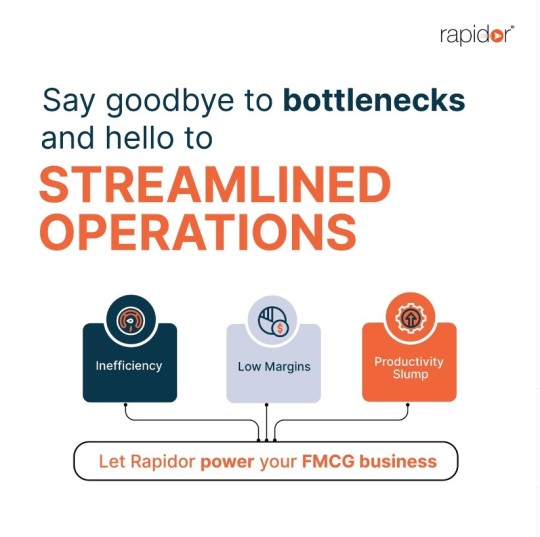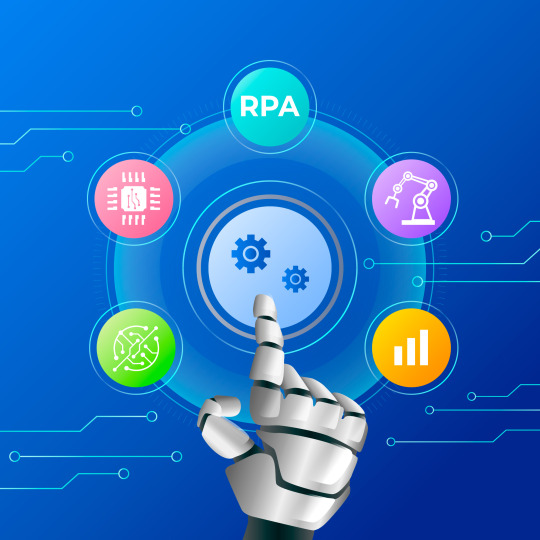#Robotic Automation Software
Explore tagged Tumblr posts
Text

Streamline FMCG Business With Rapidor's Robotic Automation Software
In the fast-paced world of FMCG, operational efficiency is key to thriving amidst high volumes and tight margins. With Rapidor's cutting-edge automation solutions, you can experience a new era of productivity and profitability.
Discover how Rapidor power FMCG Business.
Visit https://www.rapidor.co/types-of-industries/fmcg/
#Robotic Automation Software#business process automation#robotic process automation software#business process automation software#business process automation services#business process automation solutions#Business management software
1 note
·
View note
Text

#a.b.e.l#divine machinery#archangel#automated#behavioral#ecosystem#learning#divine#machinery#ai#artificial intelligence#divinemachinery#robot#android#computer#computer boy#guardian angel#angel#angels#serverroom#server room#wires and cables#hardware gore#software gore#message#how dare you#sentient objects#sentient ai
84 notes
·
View notes
Text

#machine#mech#robot#mecha#machinery#robotics#cybernetics#android#zoid#cyborg#cyberware#tech#automaton#droid#humanoid#automation#exo suit#electronic#hardware#software
69 notes
·
View notes
Text
ok the second last chapter was the best one because in fairness it actually did address encoded biases in both generative and predictive AI datasets and violent outcomes for oppressed groups in policing, healthcare, resource distribution, etc. and it did make mention of the horrific exploitation of workers in the neocolonial world in cleaning datasets, moderating virtual spaces, tagging, transcribing, and other digital sweatshop work.
but the problem is that the solutions offered are more women in STEM and better regulations... with the end goal always always always of accepting and facilitating the existence and forward motion of these technologies, just with more equitable working conditions and outcomes. early in the book, there's a great aside about how generative AI being used for new forms of image based sexual abuse causes incredible harm to those who experience misogyny and also is gobbling up energy and water at exponential rates to do so. but that environmental angle gets a few sentences and is never spoken of again in favour of boosting a kinder, more inclusive inevitable AI inundated future.
but like — the assumption that these technologies are both inevitable and reformable makes all the solutions offered untethered and idealistic!
profit is mentioned throughout the book, but the system of profit generation isn't mentioned by name once. so the problems of some machine learning systems get attributed to patriarchy and profit as if those two things are separate and ahistorical, instead of products of class society with its most recent expression in capitalism.
but yeah I mean it's not presenting itself as a Marxist analysis of AI and gendered violence so I know I'm asking it to do things it was never setting out to do. but still, it's wild how when you start to criticise technology as having class character it becomes glaring how few critiques of AI, both generative and predictive, are brave enough to actual state the obvious conclusions: not all technology can be harnessed to help the collective working class. some technology is at its root created to be harmful to the collective wellbeing of the working class and the natural ecosystems we are in and of.
technology isn't inherently agnostic. it isn't neutral and then progressive if harnessed correctly, and that idealist vision is only going to throw the people and entities capitalism most exploits into the furnace of the steam engine powering the technocapitalist death drive.
you can't build a future without misogyny using tools designed to capitalise on increasingly granular data gathered from ever-increasing tools of surveillance, to black-box algorithmic substitutions for human interaction and knowledge, to predate on marginalised communities to privatise and destroy their natural resources and public services, and to function on exploited labour of unending exposure to the most traumatising and community-destroying content. and we have to be ruthless in our analysis to determine which AI technologies are designed and reliant on those structures — because not all are!
you have to be brave enough to go through all that analysis and say the thing: if we want a future of technological progress that is actually free from misogyny, we can't build it with those tools that are built by and for the capitalist class and are inextricable from their interests and the oppression of other groups of people that capitalism needs to perpetuate.
some technology is not fit for purpose if our purpose is collective liberation.
#the old yarn: none of us are free unless all of us are free#anyway idk i read it because a comrade was reading it and this is my beat so i wanted to know what the take was#and i just think where it did focus on actual widespread and ubiquitous predatory and exploitative gen ai tech —#like gen ai relationship chat bots‚ gen ai deepfake software‚ and gen and predictive ai embedding in societal infrastructure —#it was at its best. but the sex robot obsession felt like it was there to juice up the book#bc talking about biases in automated welfare distribution isn't sensational enough?#like again yeah it was horrific imagery but devoting a full third+ of the book to it was a choice
2 notes
·
View notes
Text
youtube
Fully automating Arduino development - Giving Claude Code access to hardware 🤖⚡️💻 https://youtu.be/Yt8mc5v7MYA
Testing Claude Code, to automate Arduino coding/debugging for Metro & OPT 4048!
#arduino#hardwareautomation#claudecode#aiinengineering#robotics#makerspace#electronics#debugging#embeddeddevelopment#iot#automation#opensource#aiintegration#hardwarehacking#wsl#colorsensor#adafruit#metroMini#llm#techinnovation#diyelectronics#machinelearning#engineering#programming#linux#python#java#software engineering#coding#techtrends
2 notes
·
View notes
Text
Unlocking Efficiency and Innovation: The Role of Robotic Process Automation (RPA)

In today's fast-paced and competitive business environment, organizations are constantly seeking ways to improve efficiency, reduce costs, and increase productivity. Robotic Process Automation (RPA) has emerged as a powerful tool that can help businesses achieve these objectives.
What is Robotic Process Automation (RPA)?
Robotic Process Automation (RPA) is a technology that allows businesses to automate repetitive, rule-based tasks. It uses software robots, also known as "bots," to mimic human actions and interact with digital systems. These bots can log into applications, navigate through screens, input data, and complete tasks just like humans would.
The Role of RPA in Business:
RPA can be used to automate a wide range of tasks across various industries and departments. Here are some examples:
Finance and Accounting: Automating tasks such as accounts payable and receivable, invoice processing, and financial reporting.
Customer Service: Automating tasks such as answering FAQs, resolving customer inquiries, and processing orders.
Human Resources: Automating tasks such as onboarding new employees, processing payroll, and managing benefits.
IT: Automating tasks such as provisioning accounts, managing user access, and deploying software updates.
Impact of RPA on Businesses:
Implementing RPA can offer numerous benefits to businesses, including:
Increased efficiency and productivity: RPA can automate time-consuming and tedious tasks, freeing up employees to focus on more strategic and value-added activities.
Reduced costs: RPA can help businesses save money on labor costs, as well as reduce errors and compliance risks.
Improved accuracy and compliance: RPA bots are programmed to follow specific rules and procedures, which can help to improve accuracy and compliance with regulations.
Enhanced process visibility and control: RPA provides businesses with a clear view of their processes, which can help them identify and address bottlenecks.
Improved customer satisfaction: RPA can help businesses improve customer satisfaction by automating tasks such as order processing and customer service interactions.
RPA Services:
Implementing RPA successfully requires a partner with expertise in the technology and a deep understanding of business processes. A comprehensive RPA solution should include the following services:
Document AS-IS Process: This involves mapping out the existing process to identify areas for automation.
Design & Development of Bots, workflows, and forms for process automation: This includes designing and developing the software robots that will automate the tasks.
Bot license (We will use the appropriate underlying technology): This provides access to the software robots and the underlying technology platform.
Infrastructure: This includes setting up the necessary infrastructure to support the Robotic Process Automation (RPA) solution.
Production Deployment of the Bots: This involves deploying the bots to production and monitoring their performance.
RPA support: This includes ongoing support for the RPA solution, such as troubleshooting and maintenance.
Test & Deploy bots to production: This involves testing the bots in a production environment and making any necessary adjustments before they are deployed to full production.
Configuration data changes: This involves making changes to the configuration data of the bots as needed.
Password updates: This involves updating the passwords of the bots as needed.
Errors in executing the Bots: This involves resolving errors that occur during the execution of the bots.
Determining the “root cause” of a recurring issue or incident & recommendations: This involves identifying the root cause of a recurring issue or incident and recommending solutions to prevent it from happening again.
Infrastructure/application related issues: This involves resolving issues with the infrastructure or applications that the bots are interacting with.
Conclusion:
RPA is a powerful technology that can have a significant impact on businesses of all sizes. By automating repetitive tasks, RPA can help businesses improve efficiency, reduce costs, and increase productivity. However, it is important to choose a reputable Robotic Process Automation (RPA) companies with the expertise and experience to help you implement a successful RPA solution.
Ready to embrace the power of RPA?
Contact us today to learn more about how RPA can help your business achieve its goals.
#robotic process automation#robotic process automation rpa#rpa automation#robotic process automation software#rpa software#robotic process automation companies#robotic process automation technology#robotic process automation in healthcare#robotic process automation in banking#rpa solution#robotic process automation for finance#process automation solution#robotic process automation services#robotic process automation for insurance#rpa system#what is rpa automation#robotic process automation solution#robotic process automation benefits#robotic process automation consulting#robotic process automation consultant#rpa service provider#rpa consulting services
2 notes
·
View notes
Text
Unlocking Productivity with Robotic Process Automation
In an era where efficiency is critical, Robotic Process Automation (RPA) has emerged as a game-changer for businesses aiming to unlock new levels of productivity. RPA allows organizations to automate repetitive, rule-based tasks by deploying software bots that work around the clock with speed and precision. This not only accelerates processes but also reduces operational costs and minimizes human error.
By taking over tasks such as data extraction, report generation, invoice processing, and customer onboarding, Robotic Process Automation frees employees from mundane workloads. This enables teams to shift their focus to strategic, high-value activities like innovation, decision-making, and customer engagement. As a result, businesses experience higher output, improved accuracy, and faster service delivery.
One of RPA's strongest benefits is its ability to scale—bots can be quickly deployed across departments without requiring major changes to existing IT infrastructure. This makes implementation fast, cost-effective, and low-risk.
From finance and HR to supply chain and customer service, RPA is transforming how work gets done. Organizations that adopt RPA early are not just improving productivity—they’re gaining a competitive edge. Unlocking productivity with RPA isn't just about doing things faster—it's about working smarter and laying the foundation for digital transformation.
#robotic automation solution#software testing#automation testing#qa testing services#qa consulting services#test management tool#automated system testing#rpa test automation#end to end testing
0 notes
Text
RPA Unleashed: The Power of Software Bots to Transform Business.
Sanjay Kumar Mohindroo Sanjay Kumar Mohindroo, skm.stayingalive.in An in-depth exploration of how software bots automate tasks, boost efficiency, and cut costs, sparks a conversation on RPA’s role in modern business. #RPA #Automation The Dawn of a New Era How Automation Sparks Business Brilliance Software bots work hard to change our world. They free up time and energy. Companies see fewer…
#automation#Business Processes#Cost Reduction#digital transformation#Efficiency Boost#News#Operational Efficiency#Robotic Process Automation#RPA#Sanjay Kumar Mohindroo#Smart Tech#Software Bots
0 notes
Text
Real-World Applications of AI in Data Analytics Across Industries
Artificial Intelligence (AI) has transformed the way businesses leverage data analytics, enabling organizations to gain deeper insights, improve decision-making, and enhance operational efficiency. Across various industries, AI-driven data analytics is revolutionizing processes, uncovering hidden patterns, and driving innovation. This article explores the real-world applications of AI in data analytics across multiple sectors, demonstrating its profound impact on modern business landscapes.
1. Healthcare: Enhancing Diagnostics and Personalized Medicine
The healthcare industry has significantly benefited from AI-powered data analytics, particularly in diagnostics and personalized medicine. AI-driven algorithms analyze vast datasets from electronic health records (EHRs), medical images, and genomic sequences to detect diseases at an early stage. For example, AI systems are being used to identify cancerous cells in radiology scans with higher accuracy than human radiologists. Additionally, predictive analytics help in forecasting disease outbreaks and patient deterioration, allowing for timely medical interventions. Personalized treatment plans are another crucial application, where AI assesses genetic data and medical history to recommend tailored therapies, improving patient outcomes.
2. Finance: Fraud Detection and Risk Management
In the financial sector, AI-powered data analytics is instrumental in fraud detection and risk management. Traditional fraud detection methods often fail to keep up with sophisticated cyber threats. AI algorithms analyze transaction patterns in real time, identifying anomalies that may indicate fraudulent activities. Machine learning models assess credit risk by evaluating an individual's financial behavior and history, enabling banks to make informed lending decisions. Additionally, AI aids in algorithmic trading, where vast datasets are processed to predict market trends and execute high-frequency trades, optimizing investment portfolios.
3. Retail: Enhancing Customer Experience and Inventory Management
Retail businesses use AI in data analytics to enhance customer experience and optimize inventory management. AI-powered recommendation engines analyze customer preferences, purchase history, and browsing behavior to provide personalized product suggestions, increasing sales and customer satisfaction. Predictive analytics help retailers forecast demand, ensuring optimal stock levels and reducing wastage. AI-driven chatbots and virtual assistants improve customer service by offering instant support and resolving queries efficiently. Furthermore, AI enables dynamic pricing strategies, adjusting product prices based on demand fluctuations, competitor pricing, and customer behavior.
4. Manufacturing: Predictive Maintenance and Supply Chain Optimization
AI-driven data analytics is transforming the manufacturing industry by enabling predictive maintenance and optimizing supply chains. Predictive maintenance uses AI to analyze data from sensors and IoT devices to detect potential equipment failures before they occur, reducing downtime and maintenance costs. In supply chain management, AI assesses historical data, market trends, and weather conditions to optimize logistics, ensuring timely deliveries and cost efficiency. Smart factories integrate AI-powered robotics and automation, enhancing production efficiency and minimizing errors.
5. Marketing: Advanced Customer Insights and Campaign Optimization
In marketing, AI is revolutionizing data analytics by providing advanced customer insights and optimizing campaigns. AI-driven sentiment analysis assesses social media and customer feedback, allowing brands to understand consumer emotions and preferences. Predictive analytics help marketers identify potential customers, improving targeting strategies. AI automates content personalization, ensuring the right messages reach the right audience at the right time. Additionally, AI enhances advertising performance by analyzing engagement metrics and adjusting campaign strategies in real-time for maximum ROI.
6. Transportation and Logistics: Route Optimization and Traffic Management
The transportation and logistics industry leverages AI-driven data analytics for route optimization and traffic management. AI algorithms process real-time traffic data, weather conditions, and historical patterns to determine the most efficient delivery routes, reducing fuel consumption and improving delivery times. Ride-sharing companies use AI to match drivers with passengers efficiently, minimizing wait times and optimizing fleet utilization. In urban planning, AI-powered traffic management systems analyze congestion patterns and suggest alternative routes to improve traffic flow and reduce emissions.
7. Energy Sector: Smart Grids and Renewable Energy Optimization
In the energy sector, AI is playing a crucial role in optimizing energy consumption and integrating renewable energy sources. Smart grids leverage AI to predict energy demand and supply fluctuations, ensuring efficient distribution and reducing power outages. AI-powered data analytics help in monitoring equipment health, preventing failures in power plants and transmission networks. Renewable energy companies use AI to forecast weather patterns and optimize solar and wind energy generation, improving sustainability efforts.
8. Education: Personalized Learning and Administrative Efficiency
The education sector is increasingly adopting AI-driven data analytics to enhance personalized learning and streamline administrative tasks. AI-powered learning platforms analyze student performance data to customize learning materials and provide personalized recommendations. Automated grading systems reduce the burden on educators, allowing them to focus on interactive teaching. Predictive analytics help institutions identify students at risk of dropping out, enabling timely interventions to improve retention rates. Additionally, AI assists in optimizing resource allocation and curriculum planning, enhancing overall educational effectiveness.
9. Real Estate: Property Valuation and Market Trends Analysis
AI-driven data analytics is reshaping the real estate industry by improving property valuation and market trend analysis. AI models assess various factors, such as location, market demand, historical pricing data, and economic indicators, to predict property values accurately. Real estate platforms use AI to recommend properties based on user preferences, streamlining the home-buying process. AI-powered chatbots assist customers in finding suitable listings and answering queries in real time, improving customer experience.
Conclusion
AI has become an indispensable tool in data analytics, revolutionizing industries by offering predictive insights, automation, and efficiency improvements. Whether in healthcare, finance, retail, or manufacturing, AI-driven data analytics enhances decision-making and drives innovation. Businesses that integrate AI for data analytics into their operations gain a competitive edge by harnessing the power of machine learning and automation. As advancements in AI and data analytics software continue to evolve, their impact across industries will only become more profound, shaping the future of business intelligence and strategic decision-making.
#data visualization softwares#data visualization tools#tools for data visualization#rpa software#robotic process automation#unified data analytics platform
0 notes
Text

#a.b.e.l#divine machinery#archangel#automated#behavioral#ecosystem#learning#divine#machinery#ai#artificial intelligence#robot#angels#angel#guardian angel#wires and cables#serverroom#server room#hardware gore#software gore#computer#sentient objects#sentient ai
67 notes
·
View notes
Text

#machine#mech#robot#mecha#machinery#robotics#cybernetics#android#zoid#cyborg#automation#electronic#hardware#software
82 notes
·
View notes
Text

IoT Solutions in Manufacturing Solutions by Mobiloitte
#Advanced Manufacturing Solutions#Manufacturing Innovation#Manufacturing Technology#Smart Manufacturing#Industrial Automation#Manufacturing Efficiency#Production Optimization#Digital Manufacturing#Manufacturing Industry Solutions#Robotics in Manufacturing#AI in Manufacturing#Manufacturing Process Improvement#IoT in Manufacturing#Manufacturing Software#Global Manufacturing Innovation#Advanced Production Techniques.
0 notes
Text
IoT Platforms: The Backbone of Connectivity
IoT platforms are revolutionizing how businesses connect and manage smart devices. They simplify operations with device management, data analytics, and seamless integration while ensuring robust security.
Emerging trends like edge computing, AI integration, and 5G connectivity are pushing these platforms to new heights. At MeshTek, we create customized IoT solutions to help businesses thrive in this connected era.
Discover more at MeshTek’s IoT Services.
#IoT#InternetOfThings#Technology#Tech#Automation#Innovation#ArtificialIntelligence#AI#Cybersecurity#MachineLearning#Robotics#SmartHome#Electronics#HomeAutomation#BigData#DataScience#iot development services#iotnbo#web development#software development#bluetooth#iotsolutions#iot platform#iot applications
1 note
·
View note
Text
Test Management Tools Compared: Features, Pricing, and Use Cases
Choosing the right test management tool can make or break your QA process.
We’ll break down essential features such as test case creation, requirement traceability, integration with CI/CD pipelines, real-time reporting, and collaboration support. Some test management tools excel in Agile environments, while others are better suited for traditional test cycles or large enterprises.
Next, we explore pricing models—from subscription-based to one-time licenses and open-source alternatives—highlighting what small teams vs. enterprises should consider.
Finally, we include use case examples from different industries (finance, healthcare, SaaS) to show how these tools fit into unique QA workflows. Whether you're looking for a lightweight solution or an enterprise-grade platform, this comparison will help you make a confident choice.
#qa services#qa software#qa testing services#qa testing software#automated software testing#software testing#automated system testing#robotic automation solution#rpa testing#test automation#test management tools
0 notes
Text
Factory Automation in pune | India
The total automation of the production process is what we mean when we talk about factory automation. Using technologies like robotic arms, hydraulic systems, and pneumatic systems to automate the construction of increasingly complicated systems is standard procedure in the manufacturing industry.
#Partner in Factory Automation#Electrical & software solutions#Process Automation Partner#Revolutionizing Process Automation#Transforming Automotive Manufacturing with Advanced Automation#WAGO Technical Solutions#Electrical & Electronic Interfaces#process automation robotics india
0 notes
Text
Streamline Workflow Automation with AI | Open Chatbot Solutions
Boost productivity with Ziobot’s AI chatbot. interact with PDFs, websites, and videos using our advanced AI-powered solutions & workflow automation.
#Workflow automation with AI#open chatbot ai#robotic process automation software#Employee productivity Software#Ziobot chatbot Features
0 notes